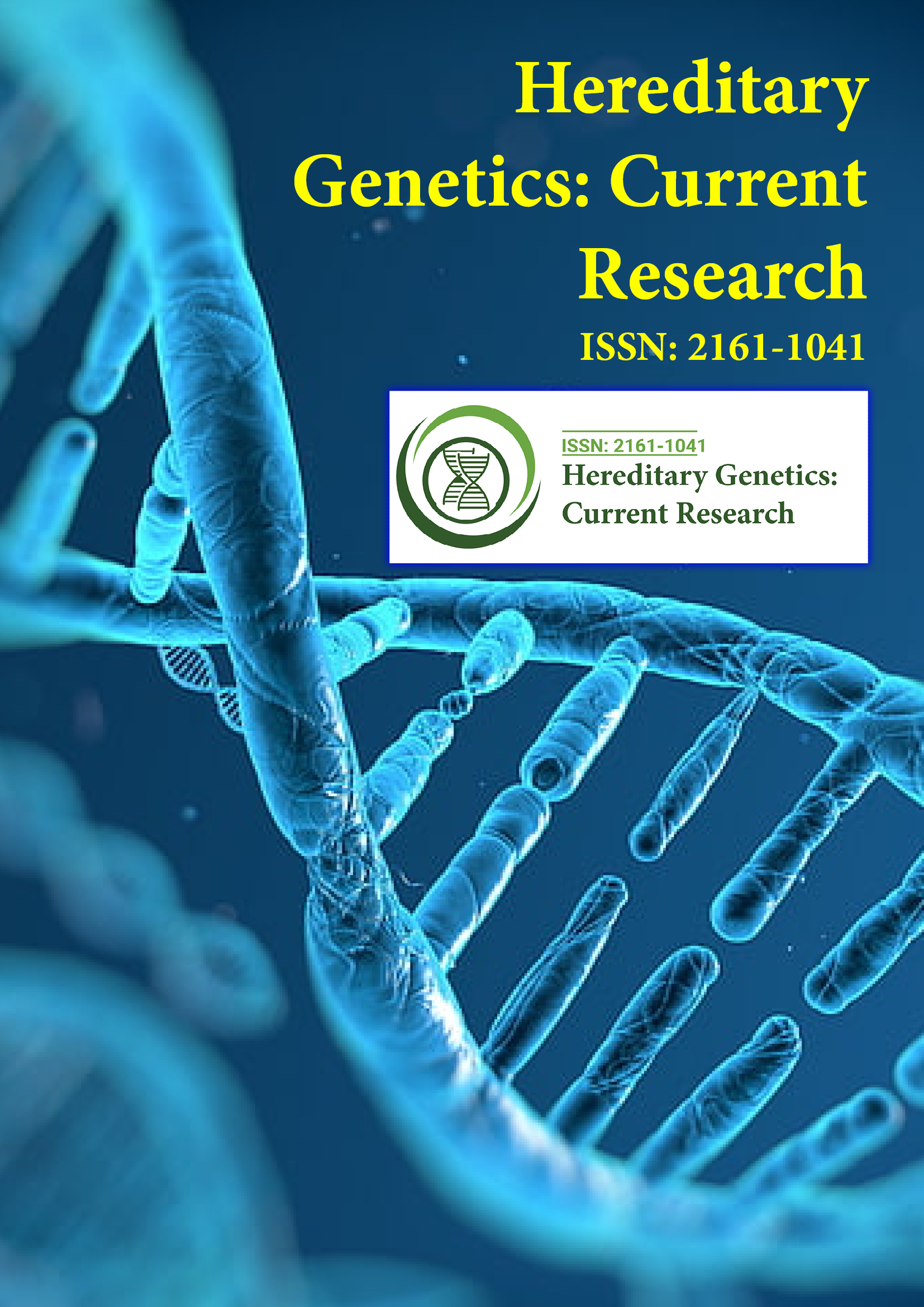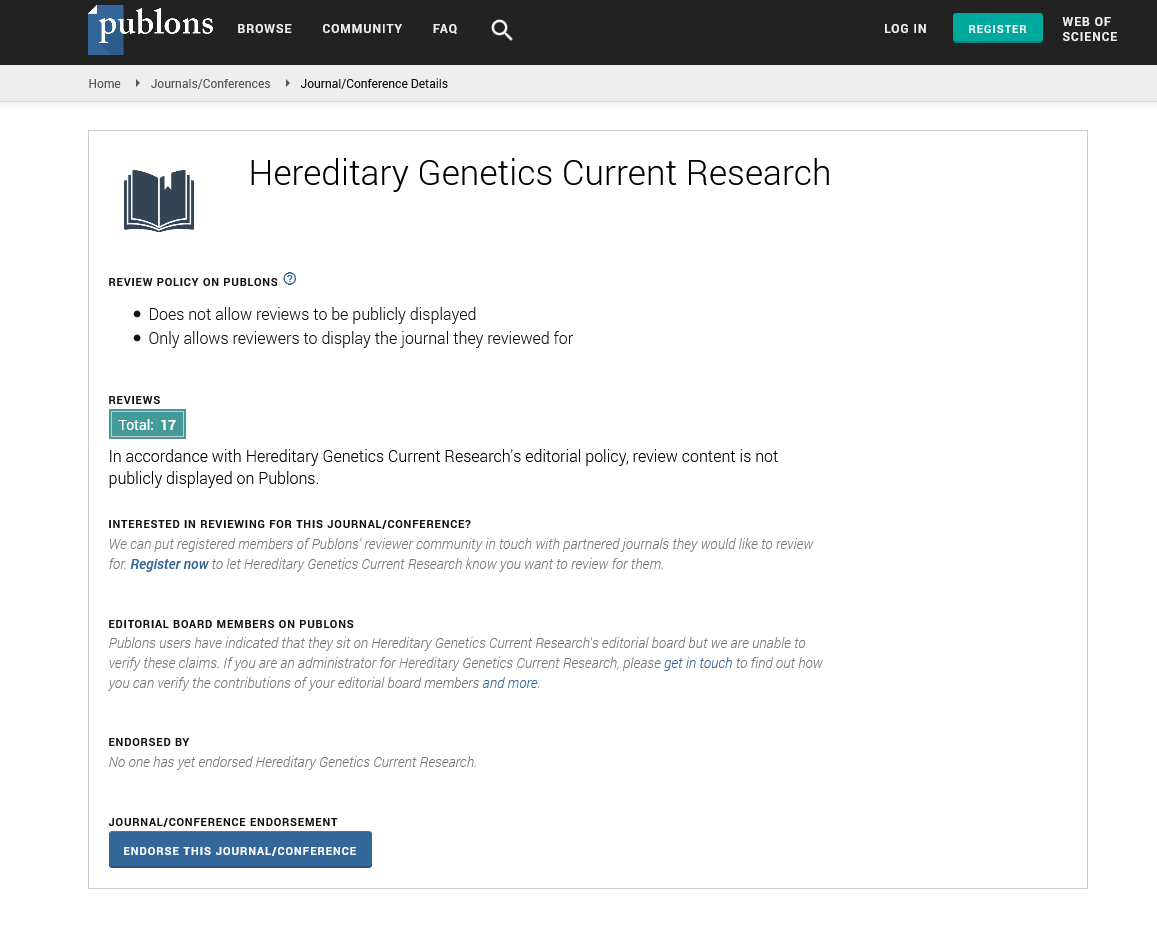Indexed In
- Open J Gate
- Genamics JournalSeek
- CiteFactor
- RefSeek
- Hamdard University
- EBSCO A-Z
- NSD - Norwegian Centre for Research Data
- OCLC- WorldCat
- Publons
- Geneva Foundation for Medical Education and Research
- Euro Pub
- Google Scholar
Useful Links
Share This Page
Journal Flyer

Open Access Journals
- Agri and Aquaculture
- Biochemistry
- Bioinformatics & Systems Biology
- Business & Management
- Chemistry
- Clinical Sciences
- Engineering
- Food & Nutrition
- General Science
- Genetics & Molecular Biology
- Immunology & Microbiology
- Medical Sciences
- Neuroscience & Psychology
- Nursing & Health Care
- Pharmaceutical Sciences
Commentary Article - (2024) Volume 13, Issue 3
Pathophysiology and Genetics of Hereditary Spinal Muscular Atrophy in Canines
Marie Alvarez*Received: 30-Aug-2024, Manuscript No. HGCR-24-28210; Editor assigned: 02-Sep-2024, Pre QC No. HGCR-24-28210 (PQ); Reviewed: 16-Sep-2024, QC No. QC HGCR-24-28210; Revised: 23-Sep-2024, Manuscript No. HGCR-24-28210 (R); Published: 30-Sep-2024, DOI: 10.35248/2161-1041.24.13.290
Description
Hereditary canine Spinal Muscular Atrophy (SMA) is a genetic disorder that affects the motor neurons of dogs, leading to progressive muscle weakness and atrophy. This condition, which has been most thoroughly studied in breeds such as the Pembroke Welsh Corgi, the Cardigan Welsh Corgi and the American Staffordshire Terrier, provides a valuable model for understanding similar human diseases, particularly the SMA that affects humans. The disease is primarily caused by mutations in specific genes that disrupt the normal function of motor neurons, leading to the gradual degeneration of these critical cells. Understanding the genetics, neurophysiology and pathology of hereditary canine SMA is essential for developing effective diagnostic tools, therapeutic strategies and potentially even gene therapies.
At the genetic level, hereditary canine SMA is most often caused by mutations in the SMN1 gene (Survival Motor Neuron 1). This gene is essential for the survival and function of motor neurons, which are responsible for transmitting signals from the spinal cord to the muscles. In both humans and dogs, the loss of SMN1 leads to the progressive degeneration of motor neurons, resulting in muscle weakness and atrophy. The severity of the condition varies, depending on whether both copies of the SMN1 gene are mutated or if there are other compensatory mechanisms in place. In dogs, SMN1 mutations are inherited in an autosomal recessive manner, meaning that an affected dog must inherit a copy of the mutated gene from both parents to develop the disease.
In addition to SMN1, other genetic factors may influence the severity and onset of hereditary SMA in canines. Research has revealed that mutations in other genes related to neuronal function, such as SOD1 (Superoxide Dismutase 1), may contribute to the pathology of the disease in certain breeds. The precise molecular mechanisms that control the onset and progression of the disease are complex, involving a combination of genetic predisposition, environmental factors and possibly other genetic modifiers that remain to be fully described. As research advances, new genes associated with canine SMA are likely to be discovered, which will help further clarify the genetic underpinnings of this disorder.
The neurophysiology of hereditary canine SMA revolves around the dysfunction of motor neurons, which are responsible for transmitting electrical impulses to the muscles. These impulses are essential for muscle contraction and voluntary movement. In dogs with SMA, the motor neurons gradually lose their ability to transmit signals, leading to muscle weakness and atrophy. The degeneration of motor neurons typically begins in the lower spinal cord and progresses upwards. This pattern of neurodegeneration results in weakness in the limbs, particularly in the hind limbs, which is a hallmark of SMA.
One of the most significant neurophysiological changes in SMA is the loss of both large and small motor neurons, which are responsible for both voluntary movements and maintaining muscle tone. These motor neurons are essential for initiating and controlling muscle movements and their degeneration leads to progressive weakness and paralysis. A characteristic feature of hereditary SMA is the absence of the reflexes in the affected limbs, a result of the breakdown of motor neuron pathways. Electromyography (EMG) and nerve conduction studies are often used in veterinary diagnostics to evaluate the extent of motor neuron dysfunction and muscle atrophy.
Conclusion
Management of hereditary canine SMA is primarily supportive, as no cure currently exists for the condition. Physiotherapy, including strength-building exercises and mobility aids, can help manage the symptoms and improve the quality of life for affected dogs. Nutritional support and weight management are also important in slowing the progression of the disease, as muscle wasting can exacerbate weakness. Researchers are describing potential therapeutic options, including gene therapy and stem cell treatments, to restore motor neuron function and slow the disease’s progression. Recent advancements in gene editing technologies, such as CRISPR-Cas9, may hold promise for future treatments of hereditary SMA, both in dogs and humans.
Citation: Alvarez M (2024). Pathophysiology and Genetics of Hereditary Spinal Muscular Atrophy in Canines. Hereditary Genet. 13:290.&
Copyright: © 2024 Alvarez M. This is an open access article distributed under the terms of the Creative Commons Attribution License, which permits unrestricted use, distribution, and reproduction in any medium, provided the original author and source are credited.

